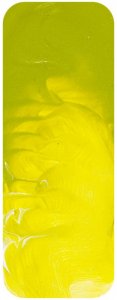Description
"When Phthalocyanine pigment was first discovered in separate labs in Switzerland and Scotland in 1907 it was a dark blue substance that was considered an annoyance as it indicated that certain experiments had failed. The chemists involved merely noted the blue colour and then proceeded to tweak their original experiments so that they could avoid the dark blue result. History would have never known about it except that a similar mistake was made in 1935 in a third laboratory but this time the chemists were curious about what the blue substance was. It quickly became apparent that it was an extraordinarily strong and light resistant pigment that could be marketed as a pigment. As they experimented they discovered that by creating the dye substance in the presence of Chlorine the blue colour was replaced with a very dark and intense green colour with similar strength and permanency as the blue colour. We call that colour Phthalo Green
Phthalocyanine Green immediately found its way into artists materials but met resistance at first in oil paint and watercolours because the well entrenched Viridian was popular. It was also a weaker and dirtier colour than Phthalo Green and artists tended to see the cleaner colour as garish along side the older pigment. When acrylics were introduced in the late 1950???s viridian proved to be unsuitable for the new medium so Phthalo Green became the standard dark green in acrylic ranges. Its many excellent qualities quickly became apparent to more and more artists causing its popularity to increase in other media as well. Today very little viridian is sold compared to the use of Phthalocyanine Green in all media and it remains as the standard dark green for acrylics.
It is a very transparent green with a jewel-like quality about the colour. It has very high tinting strength and is a very clean colour. It is used as a general purpose dark green by artists for making greens, for glazing, for adding a touch of it to reds to slightly neutralise them, and to make beautiful blacks.
Mixed with Cadmium Yellow Medium the colour it makes is a named colour called cadmium Green. Usually this is a mid green shade but if more Phthalo Green is added it makes brunswick green. Brunswick green is a standard colour from the old British standards. The darkest shade of which is called British racing green and the mid shades are the famous green of British steam trains as late as the 1950???s. Brunswick green was originally a copper colour first made in Braunschweig (Brunswick) in Germany but was later made from chrome yellow and Prussian Blue. Since Phthalo Green contains copper in its molecular structure, this mixture to make the heritage colour is very appropriate.
Different sort of greens are easily made. Try mixing Phthalo Green with Australian Ghost Gum for a mid sea green colour, with Yellow Oxide for a light olive colour or with Raw Sienna for a dark olive green.
Black is another strength of Phthalo Green. Mixed with Matisse Rose Madder it makes an intense but transparent black that is very different to the blacks in a tube. In many ways it has some of the character of the genuine Ivory Black used by the old masters. This black was literally made from burned ivory and had an intensity that the modern Ivory Black lacks because it is made from burnt animal bones instead of the ivory. A mixed black has many advantages because no two mixes are identical and so the colour has a slightly variable character that gives interest to the colour. Other dark cool reds can be substituted for the Matisse Rose Madder and each will give a slightly different black that suits different subjects.
"









